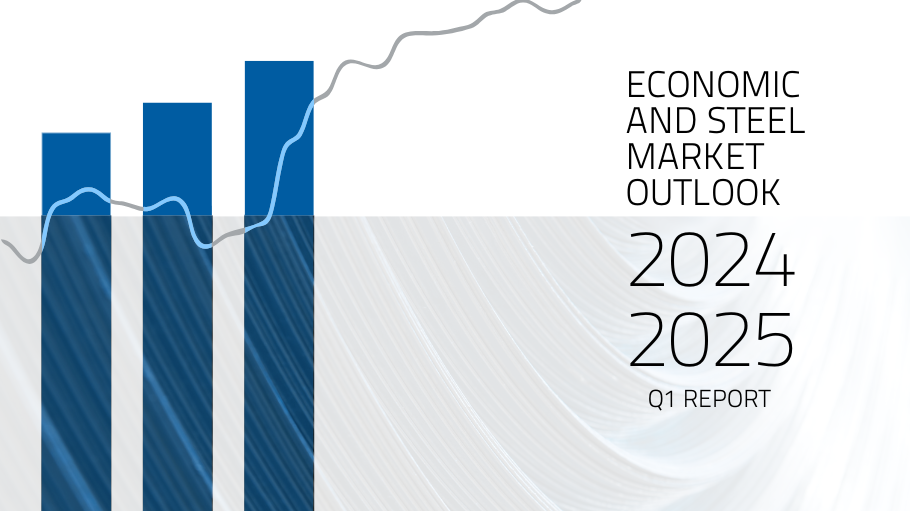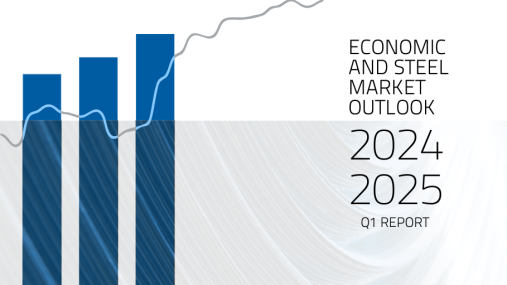
Publications » Economic and market outlook » Economic and steel market outlook 2024-2025, first quarter
Economic and steel market outlook 2024-2025, first quarter
Downloads and links
Recent updates

The negative trend in the steel market observed in the first half of 2023 is showing persistence while getting more acute. The severe consequences of the war in Ukraine and the deteriorating overall economic outlook continued to take their toll on apparent steel consumption also in the third quarter of the year. After a significant recession (-8.3%) in 2022, persistent downside factors such as ongoing conflicts, uncertainty surrounding energy prices and high inflation – albeit slowing down -, combined with a worsened economic outlook, are set to negatively impact again apparent steel consumption in 2023, for which the forecast indicates a more pronounced contraction (-6.3%) compared to the previous outlook (-5.2%). This would mark the fourth annual recession in the last five years.
This downward trend is set to weigh also on the rebound which was anticipated for this year. In 2024, conditional on more favourable developments in the industrial outlook and increased steel demand, apparent steel consumption is projected to recover at a lower rate than previously estimated (+5.6%, formerly +7.6%). The overall evolution of steel demand remains subject to very high uncertainty. Quarterly improvements in apparent steel consumption are not expected before the first quarter of 2024.
In the third quarter of 2023, apparent steel consumption dropped for the sixth consecutive quarter (-3.9%), after -8% in the preceding quarter). The total volume decreased to 30.4 million tonnes, marking the third lowest level since the outbreak of the pandemic in the second quarter of 2020.The current downturn in EU apparent steel consumption began in the second quarter of 2022, due to war-related disruptions, unprecedented rises in energy prices and production costs. Demand conditions have been worsening considerably since the second half of 2022, and this negative cycle is expected to persist at least until the fourth quarter of 2023, as a result of growing global economic uncertainty, high interest rates and overall manufacturing weakness.
Domestic deliveries continued to mirror weak demand and decreased (-2.9%) for the sixth consecutive time in the third quarter of 2023, although at a less pronounced pace than in the second quarter (-7.1%). In 2021, deliveries had rebounded significantly (+11.9%), after the sharp drop in 2020 (-9.6%) and the already negative performance in 2019 (-4.2%). As a result of the unfavourable developments in the last two quarters of the year, in 2022 domestic deliveries markedly dropped (-9.1%).
Imports into the EU including semi-finished products remained unchanged in the third quarter of 2023, after the decrease seen in the preceding quarter (-10.2%). However, it is worth noting that the drops in imports recorded in preceding quarters are essentially a reflection of weak demand conditions. Therefore, the share of imports out of apparent consumption has remained considerably high in historical terms, even in the third quarter of 2023 (27%).
In the third quarter of 2023, for the first time the Steel Weighted Industrial Production index (SWIP) went to negative territory (-0.3%), after a meagre increase (+0.4%) in the second quarter of 2023. Until then, EU steel-using sector’s output had continued to grow, showing unexpected resilience despite the protracted impact of Russia’s invasion of Ukraine, overall manufacturing weakness and global geopolitical tensions along with above-average energy prices.
The latest developments of the SWIP index were a combination of a continued downturn in the construction, mechanical engineering, domestic appliances and metalware sectors, only partly compensated by the continued growth in the automotive. The construction sector entered recession in the third quarter of 2022 and saw its fifth consecutive quarterly drop (-1.2%, after -3.4%) in the third quarter of 2023. Its recessionary trend is expected to continue. The positive trend in SWIP, started after the pandemic, continued until the second quarter of 2023 in spite of soaring energy prices impacting production costs, component shortages and lower output that took their toll on total production activity in steel-using sectors in the second half of 2022.
The deterioration of the economic and industrial outlook in the EU – particularly due to high inflation and the subsequent interest rate hike by the European Central Bank (ECB) – has had a limited impact on steel-using sectors’ output so far. The construction sector, which accounts for 35% of steel consumption in the EU, was the only significant exception.
The ongoing economic uncertainty is set to continue affecting the steel market growth over the upcoming quarters:
1. Despite EU industry having proven quite resilient up to the second quarter of 2023, the remainder of 2023 appears to be characterised by a worsening combination of uncertainties in energy prices, weak demand, inflation, geopolitical tensions and economic challenges driven by high interest rates.
2. While output grew more than expected (+3%) in 2022, SWIP growth for 2023 is forecasted to slow down (+0.7%, slightly less than previously estimated, +0.6%), albeit with wide differences among individual EU economies and industrial sectors.
3. In 2024, steel-using sectors’ growth is projected to further decelerate (+0.2%, revised downwards from +0.4%), mainly due to the second recession in a row in the construction sector, before picking up moderately (+1.5%) in 2025.

Download this publication or visit associated links
Brussels, 22 March 2024 – The future of a strong and resilient EU can only be forged with steel made in Europe. Europe-made low-carbon steel has a strategic role as it enables a net-zero economy, but today it faces strong headwinds from high energy prices, unfair competition, global overcapacity and growing unilateral carbon costs. The year 2023 has recorded the lowest European crude steel production levels ever, with a number of idled plants and dire impact on workers. Ensuring the enabling conditions for the short-term viability and the decarbonisation of the steel sector urgently needs to be at the top of the EU agenda. This is the message delivered by the European Steel Association together with a number of high-level representatives of the sector on the occasion of the Clean Transition Dialogue on Steel in the presence of the Executive Vice Presidents of the European Commission, Maroš Šefčovič and Margrethe Vestager.
Uses, limits, and realistic potentials of demand-side response from the European steel industry along with a broad set of framework recommendations for an EU policy
Antwerp, 20 February 2024 – Today 73 industry leaders spanning almost 20 industrial sectors presented ‘The Antwerp Declaration for a European Industrial Deal’ to Belgian Prime Minister, Alexander De Croo and Commission President, Ursula von der Leyen. The declaration underlines the commitment of industry to Europe and its transformation and outlines urgent industry needs to make Europe competitive, resilient, and sustainable in the face of dire economic conditions.